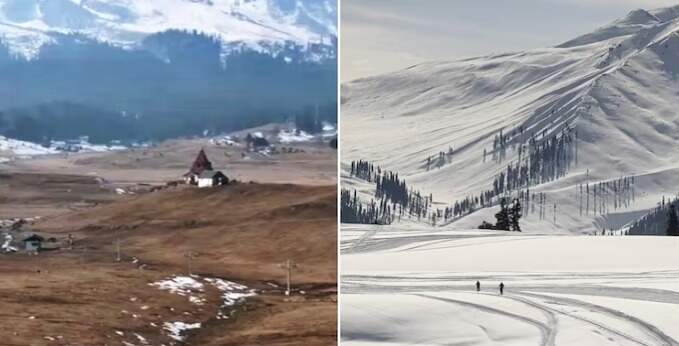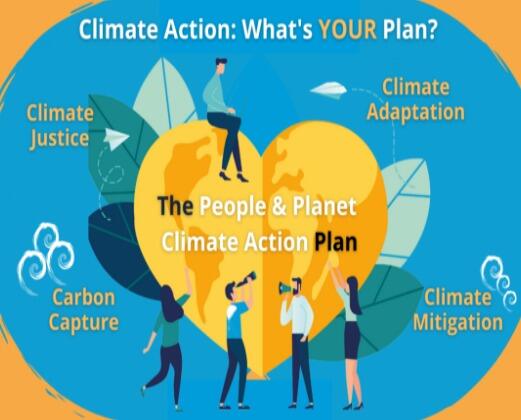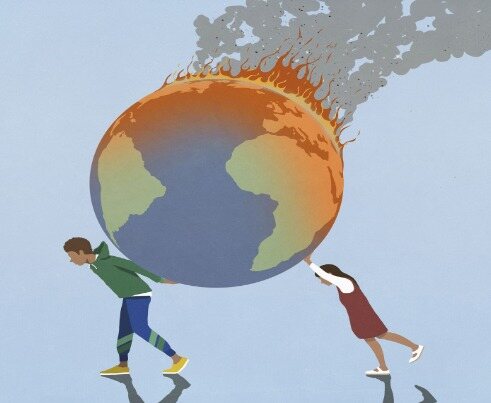In recent years, the effects of climate change have increasingly made headlines worldwide, highlighting the urgent need for action. Rising temperatures, melting ice caps, extreme weather events, and disruptions to ecosystems all point to the alarming rate at which our planet is warming.
The Intergovernmental Panel on Climate Change(IPCC) has warned that without significant reduction in greenhouse gas emissions, the consequences of climate change will only intensify, with potentially catastrophic outcomes.
Extreme weather events
From devastating hurricanes to unprecedented heatwaves, extreme weather events like climate change have wrought havoc in various parts of the world. In 2023, Hurricane Delta ravaged the Gulf Coast of the United States, causing widespread flooding and destruction, displacing thousands of people, and inflicting billions of dollars in damages. Similarly, record-breaking heatwaves in Europe and Australia led to health emergencies, agricultural losses, and strains on energy systems, highlighting the growing threat of climate-induced extreme weather.
The Arctic region continues to experience accelerated ice melt due to rising temperatures, with satellite data showing declines in sea ice extent and thickness. Several European countries including Germany, Belgium, and the Netherlands, experienced catastrophic flooding during the summer of 2021.
Satellite data and scientific observations indicate accelerated melting of the Greenland ice sheet, with unprecedented ice loss recorded in recent years. The Himalayan region, home to the world’s largest glaciers, is experiencing rapid glacier retreat. It contributes to water scarcity, threatens freshwater supplies for millions of people in Asia, and increases the risk of glacial lake outburst floods(GLOFs) in downstream areas.
Kashmir’s recent snow drought
Kashmir, renowned for its breathtaking snow-capped mountains, winter wonderlands, and popular skiing destinations, experienced an unexpected dry spell this winter. Gulmarg, known for its snowy slopes, is unusually barren, lacking its typical snow cover. The region has seen a significant 79% deficit in rainfall during December, and the anticipated snowfall didn’t occur in early January. Experts in meteorology attribute this unusual weather pattern to the El Nino phenomena.
El Nino involves the warming of sea surface temperatures in the central and eastern Pacific Ocean, impacting global weather patterns, including those affecting precipitation in Kashmir. The absence of precipitation throughout December and the early days of January was noted and the weather forecast suggested that those dry conditions were likely to continue until around January 16, with no major precipitation expected in future. Various hill spots famous for their snowfalls such as Manali also experienced snowfall very late this winter.
On the other hand, when Kashmir experienced this dry spell, a huge avalanche hit the Sonamarg area along the Srinagar-Leh Highway recently. The avalanche, captured on camera, occurred near the workshop for the Zojila tunnel construction. While avalanches are a natural hazard in mountainous regions like Kashmir, climate change is exacerbating the risk and frequency of such events. Rising temperatures, erratic precipitation patterns, and unstable snowpacks increase the likelihood of avalanches, posing grave dangers to mountain communities and infrastructure.

Impacts on ecosystems and biodiversity
Climate change poses significant risks to biodiversity and ecosystems. Habitats are being altered or destroyed, leading to a loss of biodiversity and threatening the survival of numerous plant and animal species. Coral reefs, forests, and polar regions are particularly vulnerable, causing effects on the entire ecosystems and the services they provide, such as clean water, pollination, and carbon sequestration.
Wildfires have become more frequent and intense due to prolonged drought, higher temperatures, and changing precipitation. In 2022, the catastrophic wildfires that engulfed vast swathes of the Amazon rainforest and the Western United States captured global attention. These infernos not only destroyed ecosystems and biodiversity but also released massive amounts of carbon dioxide into the atmosphere, worsening air quality, and posing significant health risks to nearby communities.
Social and economic implications
The impacts of climate change are not limited to the natural world; they also have profound social and economic implications. Vulnerable communities, including those in low-lying coastal areas and arid regions, are disproportionately affected by extreme weather events, food insecurity, and displacement. In East Africa, recurring drought and erratic rainfall patterns have decimated crops and livestock, leaving millions in need of humanitarian assistance.
Furthermore, climate-related disasters can disrupt economies, strengthen infrastructure, and exacerbate social inequalities, leading to increased poverty and instability. Rising sea levels, driven by melting glaciers and thermal expansion of seawater, pose a significant threat to coastal communities around the world. In the Pacific Island nation of Tuvalu, coastal erosion has forced residents to confront the reality of displacements and loss of livelihoods and the same scenario exists in Bangladesh.
Role of human activity
Human activities, particularly the burning of fossil fuels and deforestation, are the primary drivers of climate change. The release of carbon dioxide, methane, and other greenhouse gases into the atmosphere traps heat, causing global temperature to rise. Additionally, unsustainable land use practices contribute to deforestation and degradation of natural carbon sinks, further exacerbating the problem.
Urban areas generate heat islands due to the concentration of buildings, pavement, and vehicles, which absorb and retain heat, leading to higher local temperatures and increased energy consumption for cooling. Improper waste disposal, particularly in landfills, leads to the rise of methane, a potent greenhouse gas, as organic waste decomposes anaerobically. Individuals and collective consumer choices, including preferences for energy-intensive products, disposable goods, and fast fashion, drive demand for resources and contribute to emissions throughout the product lifestyles.
Need for immediate action
The reality of climate change demands a multifaceted approach, and various scientific methods can contribute to mitigation and adaptation efforts. Scientists are exploring a wild idea to stop our planet from overheating: sending umbrellas into space to block the sun’s warming ways. The idea has technically been around for decades now. However, other solutions also lie to deal with the current situation.
Recent research has shown that Bioenergy with Carbon Capture and Storage(BECCS) has the potential to remove significant amounts of CO2 from the atmosphere. BECCS involves using biomass for energy production while capturing and storing the resulting carbon dioxide underground. Also, some research highlighted the potential of various ocean-based solutions to mitigate climate change.

These include ocean fertilisation to enhance carbon uptake by phytoplankton, blue carbon projects to conserve and restore coastal ecosystems like mangroves and seagrasses, and ocean alkalinity enhancement to increase organs’ capacity to absorb CO2. Agricultural practices such as cover cropping, no-till farming, and agroforestry can enhance soil carbon sequestration, reducing atmospheric carbon dioxide levels. Advancements in green buildings, energy-efficient design, and sustainable urban planning can reduce heat consumption, mitigate urban heat island effects, and promote climate-resilient cities.
Conclusion
Addressing climate change requires urgent and concerted action at all levels of society. Governments, businesses, and individuals must collaborate to reduce greenhouse emissions, transition to renewable energy sources, and implement sustainable management practices. Investments in clean technology, energy efficiency, and climate resilience are essential to mitigating the worst impacts.
Moreover, prioritizing climate action can help communities adapt to unavoidable impacts, ensuring the most vulnerable populations are not left behind. The consequences of our actions today will be felt more acutely by future generations who inherit a planet profoundly altered by our choices. The time to act is Now.
-TANYA SHAH
MUST READ: LOST ON TRANSLATION: UNDERSTANDING LANGUAGE DYNAMICS IN KARNATAKA


